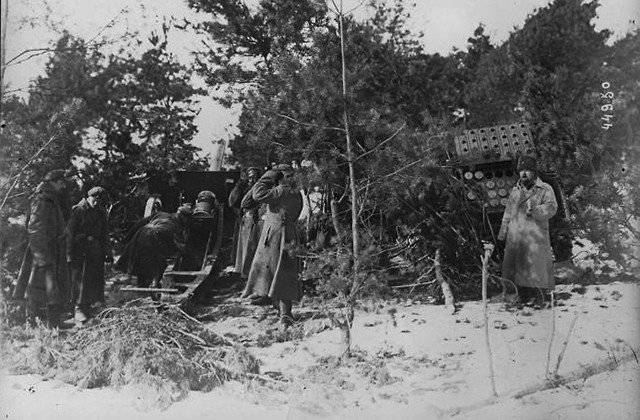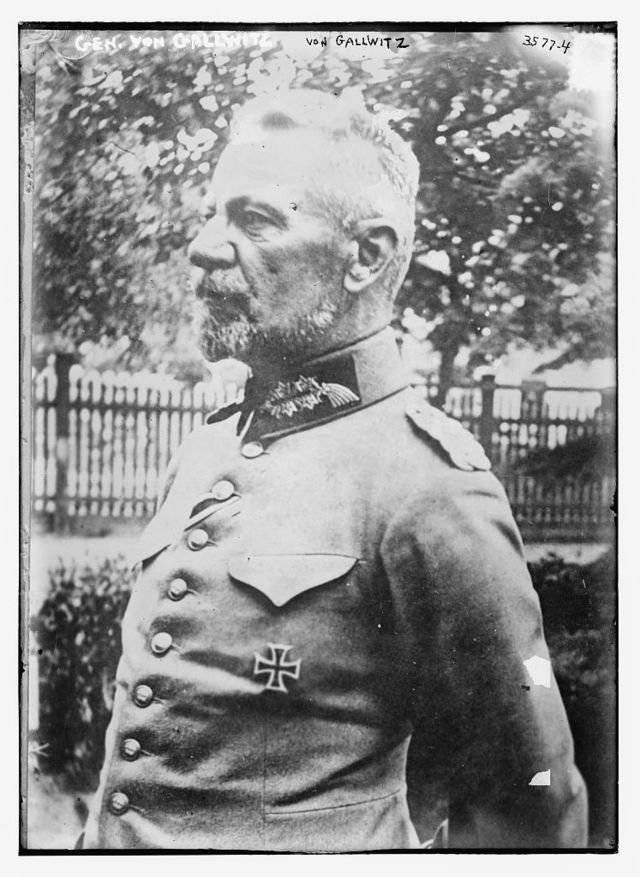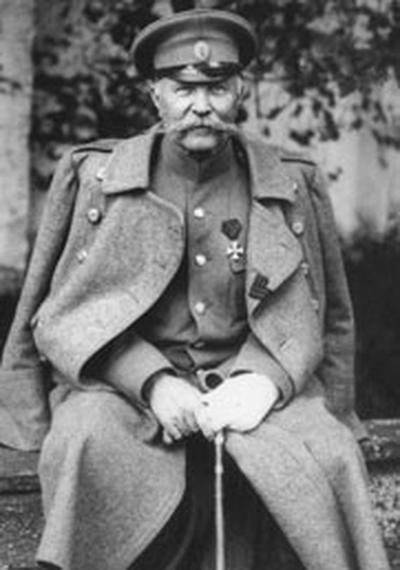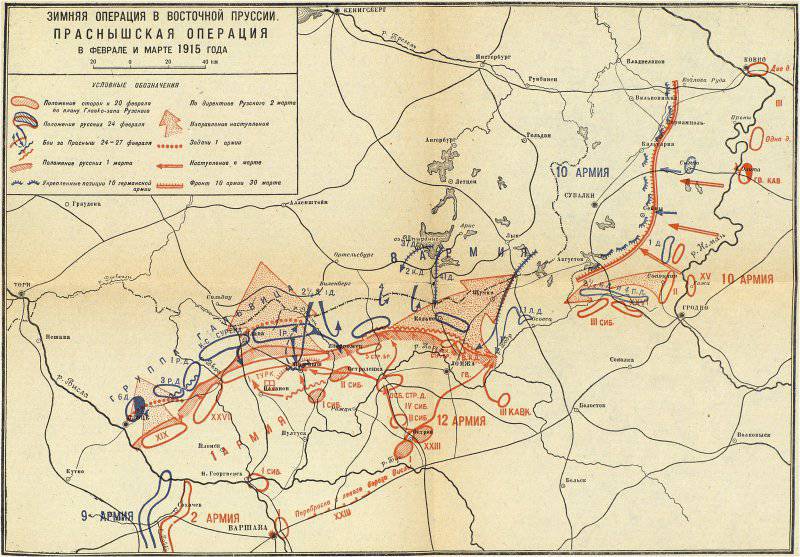Battle for Prasnysh
At a time when the 10-I Russian army led unequal battles with the superior forces of the 8 th and 10 th German armies, the newly formed 12-I and the 1 thrown from the left bank of the Vistula river ended up concentrating and deploying I am Russian armies. According to the operational plan of the command of the North-Western Front, they were to form a front strike group (8 army corps) to invade East Prussia. Russian troops received the task of striking Soldaus and advancing further into East Prussia. However, the plan for a deep invasion of East Prussia was foiled by the German offensive from East Prussia and the defeat of the 10 of the Russian army (Death of the 20 Russian Corps).
Therefore, the 1 Army under the command of General Alexander Litvinov received a more limited task - to cover the approaches to Warsaw, launching an offensive in the north-west direction, without waiting for the final concentration of Pavel Plehve's 12 Army. The main attack was to be inflicted by the left flank of the 1 Army, on the western flank in the Prasnysh area remained the weak parts of the 1 th Turkestan Corps and General Himets' cavalry.
The German army group Galvitsa (three army corps and one cavalry division) and parts of the right wing of the 8 Army (4 infantry and 1 cavalry divisions) acted against these forces from the Germans. The commander of the Eastern Front, Paul von Hindenburg, assigned the commander of the army group, Max von Halwitz, the task of deterring the possible advance of the Russian troops and thereby ensuring the flank and rear of the German armies advancing from the Masurian Lakes region. The Galvitsa group covered the Narew direction, which was of strategic importance. The firm retention of the Vlotslavsk, Mlawa and Johannesburg region was an important prerequisite for the successful development of the winter operation in Masuria, which was part of the strategic plan of the German command to encircle and destroy the Russian armies in the "Polish bag".
The German command was aware of the preparation of the Russian offensive. Russians prepared too openly. The concentration of Pavel Plehve’s 12 Army was too slow. The army should have been composed of four corps: the 1 of the Turkestan, the 4 of the Siberian, the 27 of the 1 of the 15 army, and the 7 of the cavalry divisions united in three groups. However, only two corps were ready for the 7 (20) February, the 1-st Turkestan in the Prasnysh area and the 4-th Siberian - at Plotsk.

Russian artillerymen in northern Poland
Battle
The German command decided to preempt the Russian offensive, seeking to use the success of the German forces in the August operation. Army group Galvitsa went on the offensive, trying to create a threat to Warsaw from the east. At the beginning of the battle, German troops had an advantage. The army group of General Galvitsa had the corps of generals Tsastrov, Dikhgut, the 1 th reserve corps (it was transferred to the beginning of the operation from the 9 army), the 1 th guards division, part of the 20 corps, a division of the Landsturm (Militia) and 2 cavalry divisions. The Germans had the advantage of heavy artillery. Directly on the Mlavskiy (Prasnyshsky) direction, the corps of Tsastrova, the 1-th reserve corps, part of the 20-corps, the landsturm division (total 2,5 of the corps) were advancing.
At the initial stage of the battle, German troops were confronted by the 1 th Turkestan, 27 th and 19 th army corps, 1 th Cavalry Corps of General Oranovsky, equestrian group of General Erdely and other cavalry units from the 1 th Litvinov army. Total 3 corps and 9,5 cavalry divisions. Thus, the Russian troops had an advantage in cavalry, yielding in the infantry and artillery. It is also worth noting that the Russian divisions had a large shortage of personnel, were experiencing a shortage of ammunition, which gave the Germans an advantage in the beginning of the battle.

Commander of the German Army Group Max von Halwitz
Already starting in late January, the German corps of General Dikhgut and the 1-I Guards Reserve Division attacked the left flank of the 1-th Russian army, squeezing Russian cavalry. The Russian command sent the 27 and 19 corps to the dangerous direction. Fighting on the left flank of the 1 of the Russian army went with mixed success. Russian troops pushed the Germans, then the German troops forced the Russian cavalry to withdraw, in the end, the fighting took a protracted nature.
Thus, the diverting blow of the German army on the left Russian flank tied the main forces of Litvinov's 1 Army - the 27-th, 19-th army and the 1-th cavalry corps. Prasnysh direction, where the German command was going to deliver the main attack, was weakened. In the Prasnysh direction 4 (17), two German army corps launched an offensive.
7 (20) February, the German 1-th Reserve Corps, without encountering much resistance, bypassed Prasnysh from the east and southeast. The commander of the 1 Army, Alexander Litvinov, still believed that the main events were taking place on the left flank of the army, and he did not take decisive measures to eliminate the German breakthrough in the Prasnysh direction. 8 (21) February, German troops launched an assault on the Prasnysh positions. On the same day, the front command indicated to Litvinov that the Mlav direction was the main one. The offensive on the left flank of the 1 Army, in the conditions of the movement of the Germans on Prasnysh, was called inexpedient. The 1 Army received the task of stopping the offensive on the left flank, regrouping forces and creating a strong army reserve in the Prasnysh direction.
Thus, only when the German troops had already bypassed Prasnysh, in fact, surrounded him, General Litvinov refused to attack on the left flank, and then under the pressure of the higher command. 11 (February 24) German troops captured Prasnysh, breaking the resistance of the weaker Russian forces.
Meanwhile, two new Russian corps, the 1 and 2 of the Siberian corps, were rushing to the battlefield. Corps to 7 (20) February ended the transfer by rail and concentrated in the area of Ostrov and Serock. However, the advance of the Siberian corps was not coordinated, since the 2 of the Siberian corps was subordinated to the commander of the 12 army, and the 1 of the Siberian corps was commanded by the 1 army. This slowed down the Russian offensive and gave it a poorly organized character.
In addition, the commander of the 1 Army Litvinov until the last moment kept the main forces of the army on the left wing. Only 12 (25) in February 1 th cavalry corps began to withdraw from the battle on the left flank, the cavalry was given the task of focusing on the direction of Mlavskom. The next day, the 19 Army Corps received the same task. The cavalry from the left flank of Litvinov’s army arrived only to the end of the Prasnysh battle. As a result, the Russian command was unable to organize a concentrated attack on the German troops in the Prasnysh area and use superiority in cavalry.
The German command, having received news of the approach of the two Russian corps, decided to go on the defensive. The 12 (25) of February, units of the 1 and 2 of the Siberian corps went on the offensive and broke the resistance of the German 36 reserve division holding the defensive in the south and the 9 of the Landwehr brigade in the east. 13 (26) February, Russian troops continued their offensive, crowding the enemy. However, the opportunity for a deep coverage of the German troops in the Prasnysh area was not used. The commander of the 2 Siberian Corps, having received instructions from the commander of the 12 Army Plehve about the pursuit of German troops and their coverage from the north, sent around only one regiment, which in this situation was clearly not enough. As a result, although the enemy was crushed, freeing Prasnysh, it was not possible to create an environment ring.
14 (27) February began the assault on Prasnysh. Attack Prasnysha began at different times. Part of the 1-th Siberian division (1-th Siberian corps) began the battle on the eastern outskirts of the city. Troops of the 4 Siberian Division (2 of the Siberian Corps) attacked from the north and south. By evening, Prasnysh was cleared of the Germans. During the fighting in the Prasnysh area, about 10 thousand prisoners were captured.
15 (28) February Litvinov ordered the pursuit of defeated German troops. However, in essence, the persecution was not organized. The cavalry attached to the Siberian corps did not receive any specific tasks, and so it remained in the second echelon of the advancing troops. The cavalry from the left flank of the 1 Army arrived late and did not take part in the pursuit. This allowed the German troops to easily break away from the Russians, organize a systematic departure in the north-west direction and avoid complete defeat.
February 17 (March 2), the troops of the 1, 12 and 10 of the Russian armies launched a general offensive. However, they were moving slowly, which allowed the German troops to recover from the defeat and organize resistance to previously prepared positions in the area of the state border. German troops put up stubborn resistance, and the battles took a positional, protracted nature. Attempts by the Russian armies to break through the well-prepared enemy defenses were not successful. In addition, Russian troops attacked the enemy without reconnaissance of enemy positions and artillery preparation, since the artillery had no shells. The unprepared offensive failed.
February 22 (March 7) German troops again tried to organize an offensive on the Prasnysh direction. The connections of the 2 Siberian Corps were pushed back almost to Prasnysh. The Russian command, in order to counteract this offensive, transferred the 23 Army Corps to the threatened sector. Russian troops defeated the left wing of the army group and stabilized the front. German troops again moved to Mlava and Horzhela. The fights again took on a positional character and by mid-March 1915 were finally silenced.
Having assessed the situation, the Russian Stake came to the conclusion that the continuation of the offensive does not make sense. 1 (14) March Chief of Staff of the Supreme Commander of the Russian Army Nikolai Yanushkevich instructed the command of the North-Western Front to consolidate on the achieved lines and put the army in order after the last battles. The development of the Prasnysh operation, in the opinion of the Headquarters, did not promise victories for the Russian troops. 4 (17) in March Ruzsky gave the advancing armies instructions on how to organize active defense of the Middle Neman, Beaver and Narev lines and hold the bridgehead on the left bank of the Vistula. At this Prasnysh operation ended.
Map source: Zayonchkovsky A.M. World War 1914 — 1918.
Results
Ruzsky, citing ill health, asked to relieve him of his post as front commander. His requests were granted. The North-Western Front was headed by Mikhail Alekseev, who previously was the Chief of Staff of the armies of the South-Western Front. Instead, Vladimir Dragomirov was appointed chief of staff of the South-Western Front.
The German forces could not defeat the Russian troops, who concentrated on the Mlav direction (1 and 12 armies). The Germans were able to take Prasnysh with a sudden blow, but during the Russian counteroffensive they were defeated and were forced to retreat to their fortified positions on the state border. After the retreat of the 10 of the Russian army and the death of the 20 of the army corps in the August forests, this battle stabilized the front on the right flank of the strategic front.
The Prasnysh operation completed the winter fighting on the right wing of the strategic Russian-German front. Their overall result was the disruption of the strategic plan of the German command to reach Russian forces from the north. However, the plan of the Russian command for the deep invasion and defeat of the German forces in East Prussia was destroyed, which in the future allowed returning to the plan of an offensive in the Berlin direction.
At the same time, the operations of the Russian troops on the Eastern Front favorably affected the position of the Allies on the Western Front. The attention and forces of the German command were diverted from France, which created the conditions for the accumulation of human and military material resources.
Assessing the actions of the parties, military historians point out that, as before, Russian troops fought bravely and stubbornly, despite supply problems and the heightened shortage of ammunition. Russian military historian Andrei Zayonchkovsky noted that “... in the actions of the western group of Russian troops, one positive fact can be noted - it is more and more rooted in the habit of private chiefs to respond to a counter-strike. The Prasnysh operation is a positive model in this respect. ” However, the same drawbacks were still observed. Work on the mistakes of the operations of the campaign 1914 g. Poorly. Intelligence was poorly organized, which allowed the enemy to organize a surprise attack on Prasnysh. During the counteroffensive, as the 2 and 1 Siberian corps approached Prasnysh, reconnaissance was also poorly organized, despite the presence of numerous cavalry.
The high command of the Russian troops did not perform its tasks well. The Comfront of Ruzsky, although it was he who insisted on a new strike on East Prussia, could not organize a strategic operation. The commander of the Russian army 1 th Litvinov, fascinated by the operation on the left flank, did not provide his right flank, which led to the capture of Prasnysh by the Germans. There was no proper interaction between the 1 and the 12 in the Russian armies and the 1 and 2 in the Siberian corps. The persecution of the retreating German troops was very poorly organized; the numerous Russian cavalry, which, in essence, were inactive, were not used.
The German command, as in a number of previous operations, underestimated the enemy. The offensive was launched with insufficient forces. An attempt to preempt the Russian troops failed, which was caused by shortcomings in troop control.
In the Prasnysh operation, Russian troops lost about 40 thousand people killed, wounded and captured. The total losses of the German army amounted to about 60 thousand people.

Commander of the 1 Army, Alexander Ivanovich Litvinov

Information